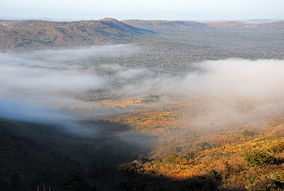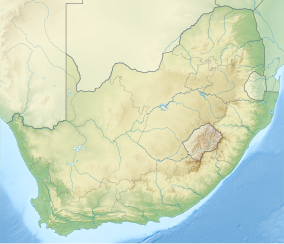Hluhluwe–Imfolozi Park
| Hluhluwe–Imfolozi Park | |
|---|---|
 A morning vista over the park | |
 Hluhluwe–iMfolozi Park | |
| Location | KwaZulu-Natal, South Africa |
| Nearest city | Durban, South Africa |
| Coordinates | 28°13′11″S 31°57′7″E / 28.21972°S 31.95194°ECoordinates: 28°13′11″S 31°57′7″E / 28.21972°S 31.95194°E |
| Area | 960 km2 (370 sq mi) |
| Established | 30 April 1895[1] |
| Governing body | Ezemvelo KZN Wildlife |
Hluhluwe–Imfolozi Park, formerly Hluhluwe–Umfolozi Game Reserve, is the oldest proclaimed nature reserve in Africa. It consists of 960 km² (96,000 ha) of hilly topography 280 kilometres (170 mi) north of Durban in central KwaZulu-Natal, South Africa and is known for its rich wildlife and conservation efforts.[2] The park is the only state-run park in KwaZulu-Natal where each of the big five game animals can be found.[2]
Due to conservation efforts, the park in 2008 had the largest population of white rhinoceros in the world.[3]
History[]

Throughout the park there are many signs of Stone Age settlements.[4] The area was originally a royal hunting ground for the Zulu kingdom,[5] but was established as a park in 1895.[2] The Umfolozi and Hluhluwe reserves were established primarily to protect the white rhinoceros, then on the endangered species list.[4] The area has always been a haven for animals as tsetse flies carrying the nagana disease are common, which protected the area from hunters in the colonial era.[4] However, as the Zululand areas was settled by European farmers the game was blamed for the prevalence of the tsetse fly and the reserves became experimental areas in the efforts to eradicate the fly.[4] Farmers called for the slaughter of game and about 100,000 animals were killed in the reserve before the introduction of DDT spraying in 1945 solved the problem.[4] However, white rhinoceros were not targeted and today a population of about 1000 is maintained.[4] On 30 April 1995, the then President Nelson Mandela visited the then Hluhluwe Game Reserve to celebrate the park's centenary. Hluhluwe–Imfolozi was originally three separate reserves that joined under its current title in 1989.[4]
Geography and climate[]

The park is located in the province of KwaZulu-Natal on the east coast of South Africa. The park is closest to the town of Mtubatuba , Hluhluwe village and Hlabisa village. The geography of the area differs from the north, or Hluhluwe area, to the south, or Umfolozi area. Hluhluwe–Imfolozi Park is partly in a low-risk malaria area.[6]
Umfolozi[]
This area is situated between the two Umfolozi Rivers where they divide into the Mfolozi emnyama ('Black Umfolozi') to the north and the Mfolozi emhlophe ('White Umfolozi') to the south.[4] This area is to the south of the park and is generally hot in summer, and mild to cool in winter, although cold spells do occur.[2] The topography in the Umfolozi section ranges from the lowlands of the Umfolozi River beds to steep hilly country, which includes some wide and deep valleys. Habitats in this area are primarily grasslands, which extend into acacia savannah and woodlands.
Hluhluwe[]
The Hluhluwe region has hilly topography where altitudes range from 80 to 540 metres (260 to 1,770 ft) above sea level. The high ridges support coastal scarp forests in a well-watered region with valley bushveld at lower levels.[7] The north of the park is more rugged and mountainous with forests and grasslands and is known as the Hluhluwe area,[3] while the Umfolozi area is found to the south near the Black and White Umfolozi rivers where there is open savannah.[3]
Biodiversity[]

Fauna[]
The park is home to Africa's big five game: elephant, rhinoceros (black and white), Cape buffalo, lion and leopard. It is home to 86 special species[8] including: Nile crocodile, hippo, cheetah, spotted hyena, blue wildebeest, jackal, giraffe, zebra, waterbuck, nyala, eland, kudu, impala, duiker, suni, reedbuck, common warthog, bushpig, mongoose, baboons, monkeys, a variety of tortoises, terrapins, snakes and lizards.[2] It is one of the world's top spots for viewing nyala. The park is a prime birding destination and is home to 340 bird species.[8] The Hluhluwe River Flood Plain is one of the only areas in the whole of South Africa where yellow-throated, pink-throated and orange-throated longclaw species can be seen together.[2] Bird life include night heron, Wahlberg's eagle, Shelley's francolin, black-bellied korhaan, Temminck's courser, Klaas's cuckoo, little bee-eater and crested barbet.[4]
Flora[]
The park has a diverse floral community.[8]
Conservation efforts[]

African wild dog[]
In 1981, the Natal Parks board (now Ezemvelo KZN Wildlife) attempted to reintroduce African wild dogs into the park. Twenty-three dogs were released in the reserve, most of which had been bred in zoos. However this met with limited success and by 2015, the population had fluctuated between 3 and 30 individuals.[9]
Rhinoceros[]

The park is the birthplace of rhino preservation, breeding the species back from extinction. As the home of Operation Rhino in the 1950s and 60s (driven largely by the park's warden, Ian Player), the park became world-renowned for its white rhino conservation.[10] The Rhino Capture Unit of the park helped save the endangered white rhino from the brink of extinction. As of 2008 there are more than 1,600 white rhino in the reserve and hundreds of the animals have been moved from here to game reserves around the world.[5] The success of this programme has recently been compromised by the increase in rhino poaching within the park. This recent threat has not only become a great concern for the park, but for rhino conservationists countrywide.[11] On 6 March 2020 two of three suspected rhino poachers were killed in a shootout, after an infrared camera automatically alerted the operations centre, providing number of persons, grid reference and direction of the incursion. This came after the loss of 28 rhinos in a year. Hluhluwe–Imfolozi has implemented Smart Park which facilitates the integration of systems, including drone technology, for early detection and rapid response of reaction units.[12]
Tourism[]
The first visitor camp was built at Hilltop in 1934.[8] The reserve has a 300-kilometre (190 mi) road network.[8]
Controversy[]
Some controversy arose in 2014 over plans to build an open-cast coal mine right on the park's border, a plan that a growing coalition of organisations is fighting to stop.[13][needs update]
See also[]
- Hluhluwe creeper
- Protected areas of South Africa
References[]
- ^ Integrated Management Plan: Hluhluwe-Imfolozi Park, South Africa (PDF) (Report). Ezemvelo KZN Wildlife. 2011. p. 5. Archived from the original (PDF) on 16 December 2012. Retrieved 24 November 2012.
- ^ Jump up to: a b c d e f "Hluhluwe–Imfolozi Park". SA Places. Archived from the original on 17 July 2018. Retrieved 7 June 2008.
- ^ Jump up to: a b c "Hluhluwe Umfolozi National Park". Game-Reserve.com. Archived from the original on 17 November 2015. Retrieved 7 June 2008.
- ^ Jump up to: a b c d e f g h i "Hluhluwe–Umfolozi Game Reserve". Hluhluwe Accommodation. Archived from the original on 15 May 2008. Retrieved 7 June 2008.
- ^ Jump up to: a b "Hluhluwe Umfolozi Game Reserve". Where to stay. Retrieved 7 June 2008.
- ^ "Malaria risk map for South Africa". The South African National Travel Health Network (SaNTHNet). Archived from the original on 6 March 2014. Retrieved 20 October 2014.
- ^ Cowgill, Roy; Davis, Steve; Forsythe, Erik (2001). "Hluhluwe-Umfolozi Park". Southern African Birding cc. Archived from the original on 24 May 2013. Retrieved 7 June 2008.
- ^ Jump up to: a b c d e "KwaZulu-Natal Wildlife Special" (PDF). Baobab Travel. Archived from the original (PDF) on 9 May 2008. Retrieved 7 June 2008.
- ^ Ginsberg, Joshua; Cole, Mary (19 November 1994). "Wild at heart: The African wild dog, long presecuted as vermin, is down to a few thousand; is it too late for science to come to the rescue of this species?". New Scientist. Reed Business Information Ltd (1952): 34. Retrieved 9 August 2015.
- ^ "Hluhluwe Imfolozi Park". SA-Venues.com. Retrieved 11 August 2015.
- ^ "South Africa: Bloody butchers – More rhino poached in Hluhluwe-Imfolozi Park". Zululand Observer. 3 December 2010. Retrieved 11 August 2015 – via African Conservation Foundation.
- ^ Singh, Kaveel (15 March 2020). "Two suspected rhino poachers shot dead in KwaZulu-Natal game park". m.news24.com. News24. Retrieved 16 March 2020.
- ^ "Private Site".
External links[]
| Wikivoyage has a travel guide for Hluhluwe-iMfolozi Park. |
- KwaZulu-Natal Provincial Government
- Ezemvelo KZN Wildlife (previously known as Natal Parks Board)
- South African National Parks
- Umfolozi River
- 1895 establishments in the Colony of Natal
- Nature reserves in South Africa
- Ezemvelo KZN Wildlife Parks
- Protected areas established in 1895
